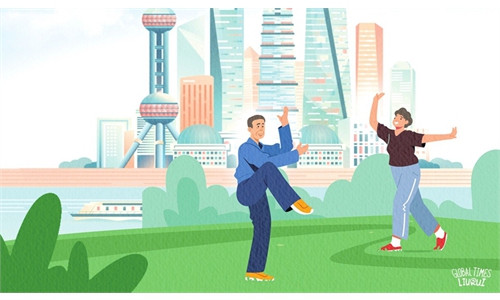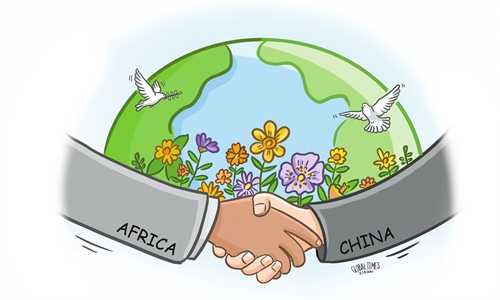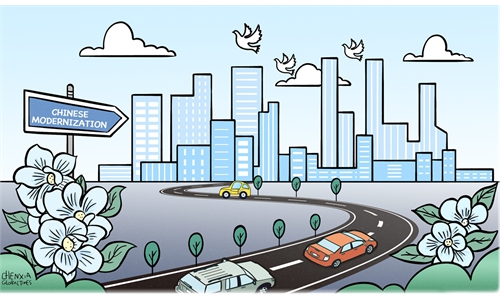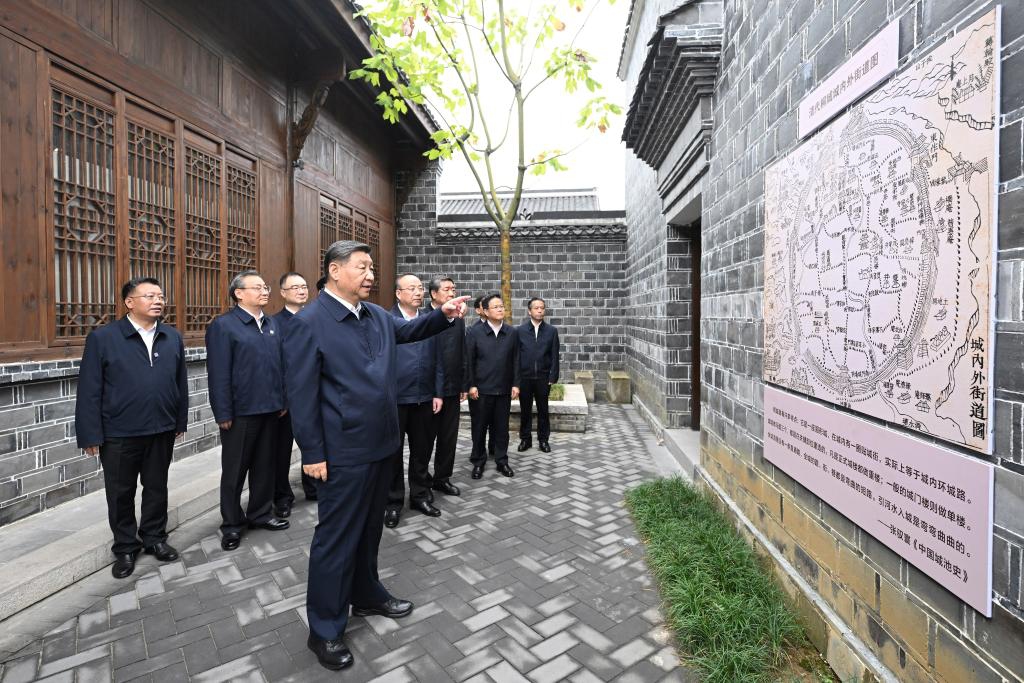
Chinese President Xi Jinping, also general secretary of the Communist Party of China Central Committee and chairman of the Central Military Commission, visits the Liuchi Alley, a historical cultural site in Tongcheng City, east China's Anhui Province, October 17, 2024. (Photo: Xinhua)
The Chinese nation possesses strong cultural creativity. In adhering to the "two integrations," (to integrate the basic tenets of Marxism with China's specific realities and fine traditional culture) Chinese modernization imparts new contemporary connotations to the outstanding traditional culture of China.
Recently, during an inspection tour in East China's Anhui Province, Xi Jinping, general secretary of the Communist Party of China (CPC) Central Committee, learned about the history and inheritance of Liuchi Alley in Tongcheng and emphasized the importance of promoting the traditional virtues of the Chinese nation, emphasizing comity and peace.
At the recent 16th BRICS Summit, Xi proposed that "we should build a BRICS committed to closer people-to-people exchanges, and we must all act as advocates for harmonious coexistence among all civilizations."
Whether during domestic inspections or foreign visits, Xi places great importance on the inheritance and promotion of China's outstanding traditional culture.
He called for culture to be drawn on to enhance China's governance and drive China's modernization, proclaiming the need to "uphold the banner of peace, development, cooperation, and win-win outcomes." He emphasized the goal of building the Earth we live on into a harmonious family.
Today, the essence of "harmony," a core value in Chinese culture, has become deeply embedded in the genetic makeup of the Chinese nation, shaping the thoughts and behaviors of the Chinese people.
The commitment of the CPC in the new era to seeking happiness for the people, rejuvenation for the nation, progress for humanity, and unity for the world is broad and profound, with roots that run deep and a legacy that continues to flourish.
Continuing the cultural lineage of China, Chinese modernization represents a new destiny for the Chinese nation. By insisting on creative transformation and innovative development, the Chinese civilization is bound to shine anew.
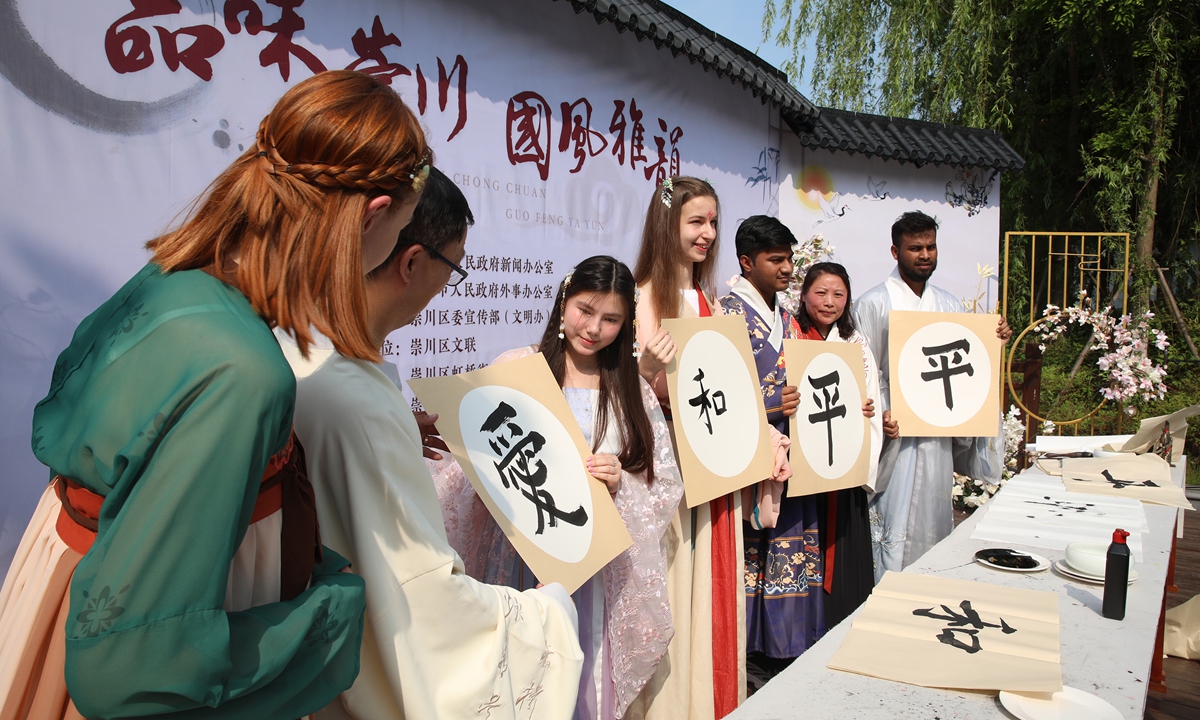
Foreign visitors showcase their calligraphy works featuring the Chinese characters conveying "love, harmony, and peace" at a cultural exchange event in Nantong, East China's Jiangsu Province. Photo: VCG
Traditional roots
"Harmony is the universal path to be pursued."
The path of harmony is rooted in cultural soul-building.
Traditional Chinese virtues are the essence of Chinese culture, rich in moral and philosophical resources.
From the phrase "harmony begets new things" in the Discourses of the States, to "harmony is invaluable" in the Analects, as well as contemporary social advocacy for family values like "harmony and beauty," interpersonal relations characterized by "calmness and peace," conflict resolution prioritizing "harmony," and business practices promoting "prosperity through harmony" - the character "he" (harmony) truly embodies the profound significance of Chinese culture.
The creativity of the Chinese civilization determines that it upholds tradition without clinging to the past and respects ancient wisdom without reverting to archaic thinking.
Today's Liuchi Alley embodies the spirit of the path of harmony and the expression of culture.
"My family's two walls stretch a hundred meters long. In between, virtue and righteousness walk, while courtesy and humility stand on either side. My family's alley is six feet wide. With infinite tolerance, harmony is hidden within poetry..." The enchanting melody of the Spring Festival Gala song "Liuchi Alley" is widely celebrated.
"Don't say that modesty yields nothing; giving roses to others leaves a lingering fragrance. Letting him have three feet becomes a beautiful story, and harmony brings auspiciousness for days and months to come..." The heartfelt melodies of the Huangmei Opera "Liuchi Alley" resonate deeply with audiences.
The wisdom and essence of Chinese culture continuously inspire new waves amid the tides of the changing times.
In Hehe town in Tiantai, a county in Taizhou, East China's Zhejiang province, over 600 creative cultural products, the animated TV series Hehe Erxian (Immortals of Harmony and Union), and the poetic musical Tianxia Hehe illuminate the culture of "harmony and unity" through past and present. The "Five Virtues Family" practice in Dongying, Shandong Province, promotes "civility, discipline, harmony, and family unity," embodying the core values of both traditional culture and modern standards of living.
The simple concept that "harmony is invaluable" is deeply rooted in the hearts of the Chinese people, serving as a vital spiritual force that sustains the continuous legacy of the Chinese nation.
China's excellent traditional culture is the foundation and spirit of the Chinese nation and the root of its resilience in global cultural exchanges.
Application in new era
The philosophy of "harmony" applies both to governance and social order.
Valuing benevolence, prioritizing the people, upholding integrity, revering justice, promoting harmony, and seeking common ground embody the spirit of China's traditional culture. We should unearth and elucidate its relevance to the times, promote Chinese culture to increase mutual understanding, and educate people through culture, to build China's spirit, values, and strengths.
Incorporating the cultural significance of the "Liuchi Alley" and its ideals of harmonious justice with practical social governance, the "Liuchi alley approach in the new era" emerged in Tongcheng, helping resolve community conflicts and advancing social governance. In 2023, this method was included in the work report of the Supreme People's Court and selected as a test case in the "Fengqiao model," which is named after a town in Zhejiang Province, and is an exemplar of Chinese community-level social governance.
"Law ensures social stability while virtue nourishes the mind."
The "three zeros" approach adopted in Mudan community in Shenyang, Liaoning Province, the "Fengqiao experience" in Mingxi County, Fujian Province, and the "Dongbula mediation" in Fuhai County, Xinjiang Uygur Autonomous Region, all transform the tradition of "harmony is invaluable" into practical governance approaches. The people's mediation system has become fundamental in diversified dispute resolution, writing a new chapter in the "two miracles."
The system of people's congress and the mechanism for political consultation initiated by the CPC are profoundly connected to the people's foundational thought of the Chinese civilization, the idea of shared governance, the tradition of "consultation," and the political wisdom of embracing diversity and seeking common ground. From harmonious courtesy to working together in harmony, to nurturing all things together, we build a peaceful China, a law-based China, and a beautiful China... In fully building a modern socialist country, harmony is an essential value for consideration.
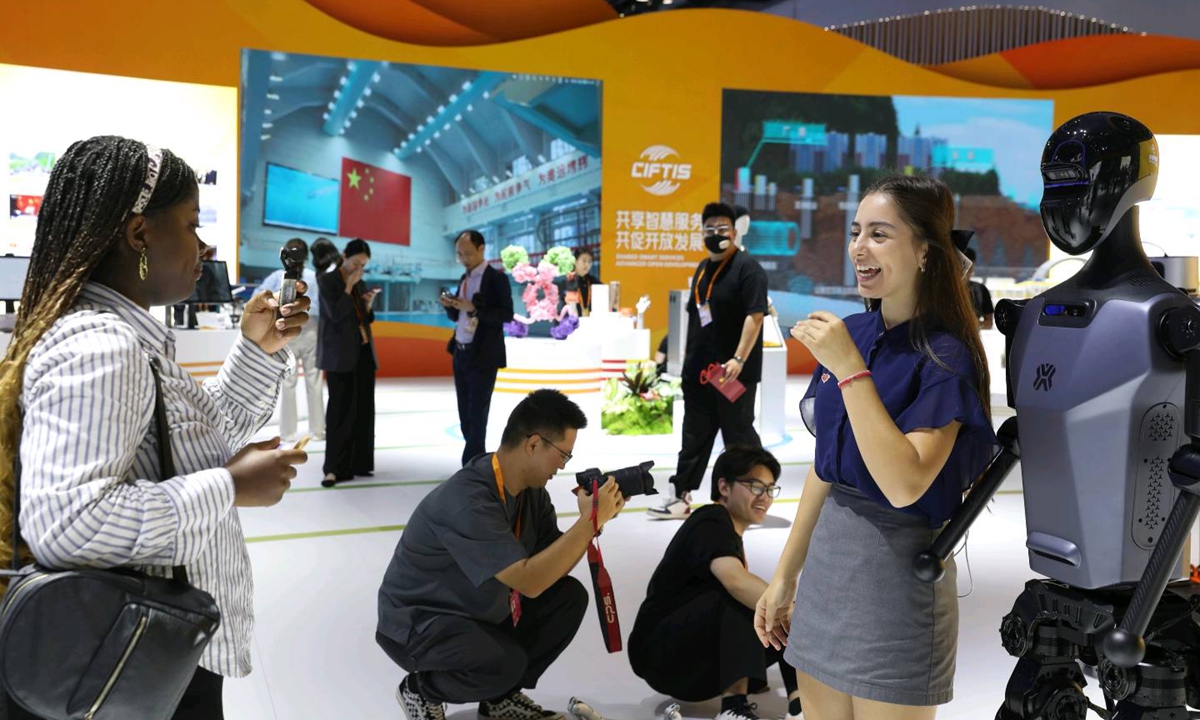
A Bulgarian student takes a photo with a robot at the China International Fair for Trade in Services, on September 12, 2024, in Beijing. Photo: VCG
Global perspective
The path of harmony is rooted in a global perspective.
Chinese modernization is one that follows a path of peaceful development. Over 200 years ago, Napoleon Bonaparte compared a backward China to a sleeping lion. In the spring of 2014, by the Seine River, Xi profoundly articulated: "Today, the lion has woken up. But it is peaceful, pleasant, and civilized."
The Chinese nation values peace; there is no gene for invading others or seeking global hegemony in our blood. Upholding trust, promoting harmony, and fostering kindness with neighbors have always been our way of interacting with the world.
China is the only major country that has enshrined peaceful development in both its Constitution and the Constitution of the Communist Party of China, elevating this principle to the status of national will. The confidence and consciousness needed to follow the path of peaceful development are deeply rooted in the rich heritage of the Chinese civilization.
From "the historical answer of the Five Principles of Peaceful Coexistence" 70 years ago to "the contemporary vision of building a community with a shared future for mankind" in the new era, the spirit of "harmony" remains consistent while also achieving significant historical leaps.
Since the advent of the new era, China has hosted China International Import Expo, the China International Fair for Trade in Services, the China Import and Export Fair, and the China International Consumer Products Expo, continuously reducing the negative list of foreign investment access, establishing free trade pilot zones, and the Hainan Free Trade Port.
China welcomes people from all over the world to ride on the "fast train" and "express bus" of its development. Adhering to the basic national policy of opening-up and steadfastly pursuing an open strategy of mutual benefit and a win-win philosophy, the door of China's opening-up is getting wider and wider, and China's circle of friends is getting larger, with more partners on the shared journey toward modernization.
China's achievement of modernization is a boost to the forces of global peace and a bolstering of the forces of international justice.
China's journey toward modernization is guided by a deep concern for the future of humanity and a profound commitment to the well-being of its people.
At every historical juncture, culture has always felt the changes in the national fate and stood at the forefront of the times, sounding the clarion call of the era.
Countries may become partners when they have the same values and ideals, but they can also be partners if they seek common ground while reserving differences.
Mutual respect, unity, cooperation, and harmonious coexistence are the correct paths for the development of human civilization.
Advocating peaceful coexistence and harmony between civilizations, Xi's positioning for promoting the high-quality development of greater BRICS cooperation transcends the scope of BRICS, aiming at a broader global perspective and aligning with the progress of human civilization.
Harmonious coexistence is both a humanistic foundation and a humanistic pursuit; it is seeking common ground and following the righteous path. Building a community with a shared future for mankind has become a glorious banner leading the progress of the times, which will surely drive humanity to steer the great ship toward a bright future of peace, security, prosperity, and progress.
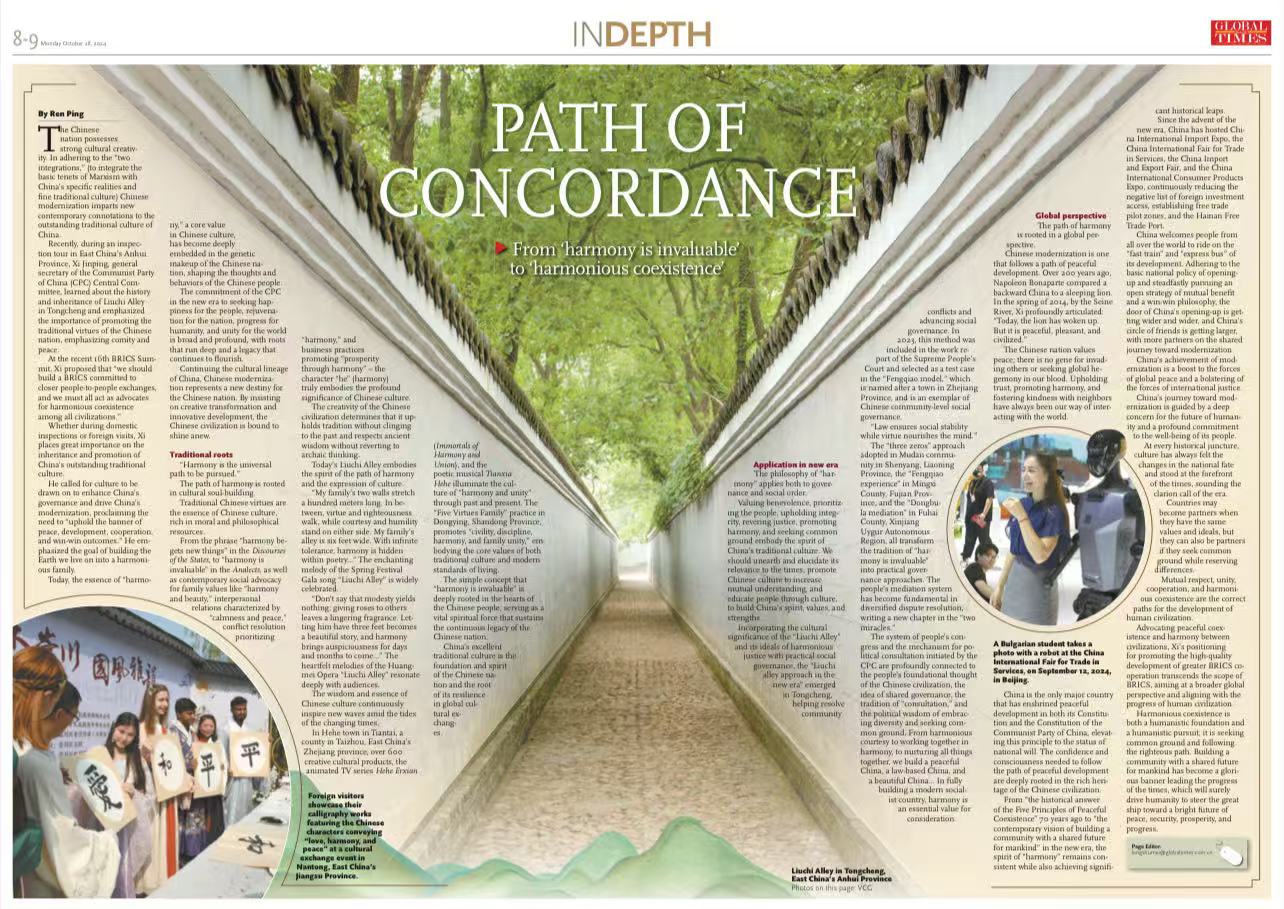
Path of concordance
